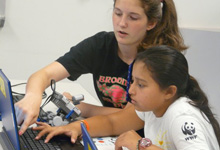
By Seth Kershner
From NNOMY.net | Original Article
Although women make up about half of the United States workforce, they represent just 24 percent of careers in STEM fields (science, technology, engineering, and mathematics). In order to correct this, major nonprofit groups have been organizing STEM enrichment camps for middle- and high-school girls, driven by the philosophy that more women will pursue STEM careers if their interest is piqued at an early age.
But recently, some girls-only STEM programs have gone beyond fostering interest in science and math among the next generation of women. Branches of the U.S. military—in particular, the Navy—have increasingly been using these programs to market the military to girls as young as 11 and 12.
Founded in 1974, Expanding Your Horizons (EYH) organizes dozens of STEM conferences for middle- and high-school girls each year. According to its website, the EYH “recently had the opportunity to partner with the Navy and learn about careers where young women are underrepresented.” They give girls the following pitch: “You probably never gave much thought to having a career with the United States Navy. Many girls don’t.… We want to introduce you to several inspiring professional women who are currently active in the Navy and serve on aircraft carriers, who serve as Navy divers, or who serve in other interesting Navy careers.” Accompanying the text is a handy-dandy link to the Navy’s recruiting website.
Although details of the partnership were hard to come by (EYH’s
interim executive director, Sheryl Bize-Boutte, said she’d have to check
with the Office of Naval Research before granting an interview), one
can divine a possible sign of Navy influence in the location of one of
this year’s EYH conferences—the Naval Postgraduate School in Monterey,
California. “Because this program is at the Naval Postgraduate School,
some of the workshops will focus on cool Navy careers,” boasts the
conference website. Many of the workshop presenters are on the Navy
payroll and teach topics like cryptology.
And on the local level,
single-sex STEM camps often seem like military recruitment lite. One
prominent example is the Pacific Aviation Museum’s Flight School for
Girls at Pearl Harbor, Hawaii. According to its website, the three-day
flight program gives girls in grades 6–8 a chance to learn scientific
principles of flight through demonstrations and experiments. In addition
to classroom instruction led by museum educators and a historical
interpreter dressed as Amelia Earhart, there’s a day set aside for
horsing around with military hardware, donning flight suits, trying out a
cool P-40 Warhawk flight simulator, and—wait for it—meeting “women in
aviation careers.” Who are these latter-day Earharts? None other than
Navy pilots, and judging by the photos from recent flight-school
sessions posted on the museum’s website, they appear to have been given
ample time to talk with small groups of girls about STEM opportunities
in the Navy.
Military support for single-sex STEM camps can be
seen as the latest iteration of an ongoing effort to expand the
military’s all-volunteer recruiting base. First, by promoting “cool Navy
careers” in areas where young women may be underrepresented (like STEM
fields), these military partnerships are engaging with what
anthropologist Hugh Gusterson calls “feminist militarism”—the complex of
cultural attitudes that convey that women can overcome second-class
citizenship by serving in the military. By the logic of feminist
militarism, it’s not enough to enter a traditionally male-dominated
field like aviation engineering—to really show you’re equal to a man,
you need to serve in the Navy.
Secondly, the Pentagon—by pushing
the idea of military service on girls as young as 11 and 12—is simply
following the advice of its own Joint Advertising Marketing Research
Studies program, which warned in its November 2011 “State of the
Recruiting Market” report that “if joining the military is not
considered by age 17, it likely will not be in later years.” The U.S.
Army Recruiter Handbook also points out that contact with seventh- and
eighth-grade students can “positively impact high-school and
postsecondary school recruiting efforts.” In other words, get ’em while
they’re young.
Unfortunately, scientists have been slow to react
to the Pentagon’s apparent co-optation of STEM instruction. Kathy
Barker, a Seattle-based writer with a PhD in microbiology, is working on
a study of scientists-as-activists. “I have never found anyone in the
scientific community concerned about militarism,” Barker told me in a
recent phone interview. But Barker herself has bucked that trend,
documenting the military’s use of STEM programs to recruit and
coauthoring a study of high-school military recruiting that was
published in the American Journal of Public Health. “Scientists have an
acceptance of and complicity with the military that few realize, much
less protest,” Barker added. “The Navy is using EYH for advertising and
recruiting. Everyone wins except the girls, who are collateral damage.”
